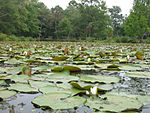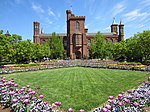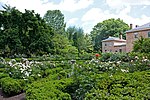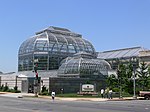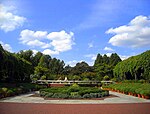
An arboretum in a general sense is a botanical collection composed exclusively of trees. More commonly a modern arboretum is a botanical garden containing living collections of woody plants and is intended at least in part for scientific study.

The United States National Arboretum is an arboretum in northeast Washington, D.C., operated by the United States Department of Agriculture's Agricultural Research Service. It was established in 1927 by an act of Congress after a campaign by USDA Chief Botanist Frederick Vernon Coville.

Ulmus crassifoliaNutt., the Texas cedar elm or simply cedar elm, is a deciduous tree native to south central North America, mainly in southern and eastern Texas, southern Oklahoma, Arkansas and Louisiana, with small populations in western Mississippi, southwest Tennessee and north central Florida; it also occurs in northeastern Mexico. It is the most common elm tree in Texas. The tree typically grows well in flat valley bottom areas referred to as 'Cedar Elm Flats'. The common name 'cedar elm' is derived from the trees' association with juniper trees, locally known as cedars.
The South Seattle College Arboretum is a 6-acre (24,000 m2) arboretum and botanical garden located at the north end of the South Seattle College campus in Seattle, Washington. It is open daily without charge. The Seattle Chinese Garden is adjacent.

Ulmus davidiana var. japonica, the Japanese elm, is one of the larger and more graceful Asiatic elms, endemic to much of continental northeast Asia and Japan, where it grows in swamp forest on young alluvial soils, although much of this habitat has now been lost to intensive rice cultivation.

Ulmus bergmannianaC.K.Schneid., commonly known as Bergmann's elm, is a deciduous tree found across much of China in forests at elevations of 1500–3000 m.

Ulmus castaneifoliaHemsley, the chestnut-leafed elm or multinerved elm, is a small deciduous tree found across much of China in broadleaved forests at elevations of 500–1,600 metres (1,600–5,200 ft).

Ulmus macrocarpaHance, the large-fruited elm, is a deciduous tree or large shrub endemic to the Far East excluding Japan. It is notable for its tolerance of drought and extreme cold and is the predominant vegetation on the dunes of the Khorchin sandy lands in the Jilin province of north-eastern China, making a small tree at the base of the dunes, and a shrub at the top.

Ulmus uyematsuiHayata, commonly known as the Alishan elm, is endemic to forests at elevations of 800–2,500 metres (2,600–8,200 ft) in Alishan, Chiayi County, central Taiwan, where it is considered one of the minor tree species. The tree was first named and described by the Japanese botanist Bunzō Hayata in 1913, in the aftermath of the First Sino-Japanese War, when Formosa was ceded to Japan.

Ulmus lamellosa, commonly called the Hebei elm, is a small deciduous tree native to four Chinese provinces, Hebei, Henan, Nei Mongol, and Shanxi, to the west and south of Beijing.

Ulmus szechuanicaFang, known as the Szechuan (Sichuan), or red-fruited, elm, is a small to medium deciduous Chinese tree found along the Yangtze river through the provinces of Sichuan, Jiangxi, Anhui, and Jiangsu.
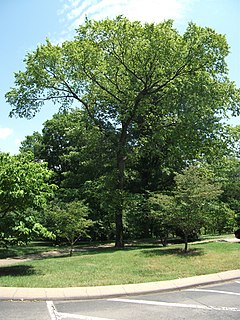
Ulmus serotinaSarg., the September elm, is an autumn-flowering North American species of tree. It is uncommon beyond Tennessee; only very locally distributed through Illinois, Kentucky, Arkansas, Mississippi, Oklahoma, Alabama and Georgia, and disjunct into Nuevo León, Mexico. It grows predominantly on limestone bluffs and along streams to elevations of 400 m.

The American Elm cultivar Ulmus americana 'Delaware' was originally selected from 35,000 seedlings inoculated with the Dutch elm disease fungus in USDA trials at Morristown, New Jersey.
The Chinese Elm cultivar Ulmus parvifolia 'Catlin' is a dwarf variety specifically raised as a bonsai plant by John Catlin, La Canada, California, circa 1950.
Ulmus bergmanniana var. lasiophyllaC. K. Schneid. is endemic to China, on mountain slopes at elevations of 2100–2900 m in Gansu, Shaanxi, north-west Sichuan, south-east Xizang, and north-west Yunnan.
Ulmus glaucescens var. lasiocarpaRehder, named the hairy-fruited glaucescent elm in the United States, is a Chinese tree found along rivers and mountain slopes at elevations of 2500–2600 m in the provinces of Hebei, Henan, Liaoning, Nei Mongol, Ningxia, eastern Qinghai, and Shanxi.

Ulmus parvifolia, commonly known as the Chinese elm or lacebark elm, is a species native to eastern Asia, including mainland China, Taiwan, Japan, North Korea, South Korea and Vietnam. It has been described as "one of the most splendid elms, having the poise of a graceful Nothofagus".




